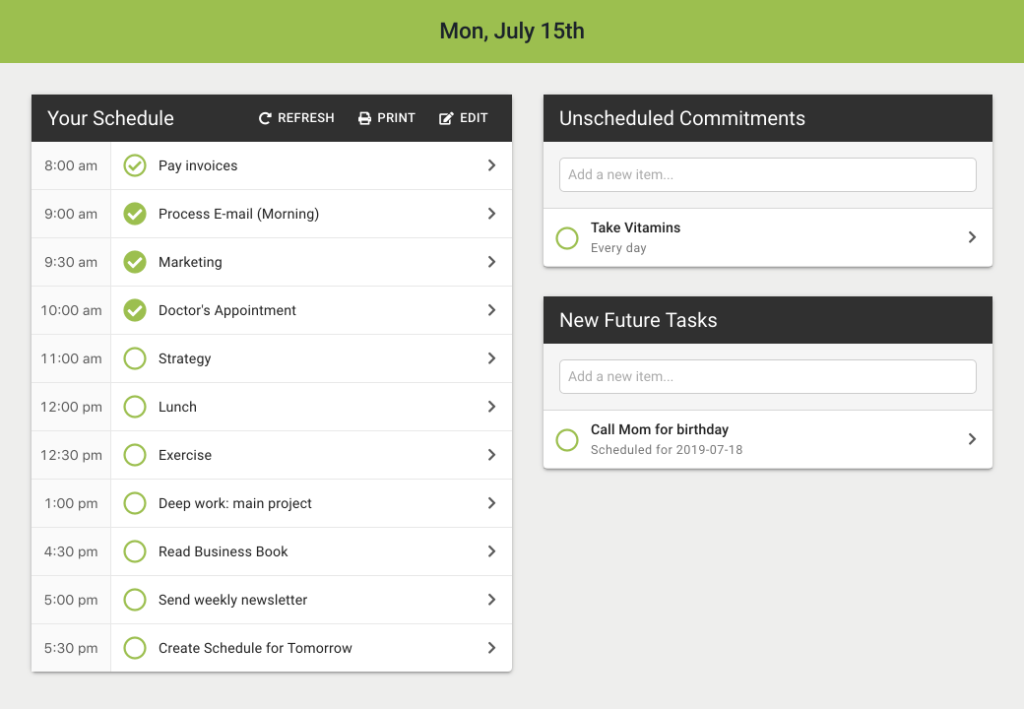The terms “task management” and “time management” are often used interchangeably, yet they are distinct disciplines. Learning the differences between the two can make you better at both.
So what exactly is the difference then?
Task management is the discipline of planning and executing what you need to do: which tasks, in what order and with which steps.
Time management is the discipline of planning and executing when you do those tasks: what time to start, how long to work and how to structure your time within those time blocks.
While intertwined—it’s impossible to do time management without doing at least some task management—the techniques and approaches used for each differ. Becoming good at both can help you boost your productivity.
Managing Your Time Using Task Management
Most people start out managing their time using task management exclusively. They don’t view “time” as first-class citizen, but a servant to the tasks they need to work on.
The process of managing your time by managing your tasks is a form of indirect time management—by focusing exclusively on your tasks, you influence how you use your time, but don’t manage it directly.
For some jobs, this is sufficient. If you work in a “single track” job where you have a single primary responsibility and your job is to work through a queue or backlog of tasks, then task management may suffice—although you may want to try other indirect time management methods like energy management, attention management or scope management.
Managing Your Time Using Time Management
If, however, you work in a job or live a life where you have multiple competing priorities, task management alone can be insufficient. Focusing purely at the task level may cause you to misallocate your time, so you are not distributing your time properly across your competing priorities.
It can also lead you to overwork yourself. Ignoring time constraints allows us to distract ourselves with lower priorities. This gives us a sense of accomplishment, but then we work longer to get the higher priorities done. Recognizing our time constraints forces us to prioritize more and get the important stuff done first.
In these situations, learning to carve up your time into discrete blocks where you work on moving each of your priorities forward will help ensure you don’t start dropping balls and leaving critical priorities to wither.
Techniques like time blocking, creating a daily schedule, pacing timers and more can help you treat time as a first-class citizen in your productivity system, enabling you to ensure your important work gets done and your priorities are handled.
An Overview of Task Management Techniques
There exist many different techniques and systems for practicing task management. In general, techniques for managing tasks fall into one of five buckets:
- Collect
Capture your tasks into repositories, as few as possible. A single task manager is ideal. If using multiple task managers, ensure you define clearly where each type of task belongs. - Organize
Assign tags to tasks or put them into folders to make it easier to retrieve specific groups of tasks later. - Prioritize
Identify which tasks need to be done sooner versus later and which tasks have the highest impact on your goals. - Elaborate
Add information that will help you execute the task more effectively, such as sub-tasks, next steps or outlines. - Eliminate
Archive or delete tasks that are no longer relevant to your goals.
Look at your current task management system and see how the techniques and systems you use fit into these buckets. Not all systems address all of these buckets. Do you have any missing pieces you need to fill in your task management system?
An Overview of Time Management Techniques
Time management also has different techniques and systems. In general, techniques for managing time fall into one of these buckets:
- Commit
Select what to do in a specific time period such as a day, week or month. - Allocate
Assign a duration for how long to spend working on your commitments. - Schedule
Decide when to start and optionally stop working on your commitments. - Evaluate
Remove lower-priority commitments you won’t have time for and rearrange commitments to optimize your plan. - Monitor
Check in on your progress at regular intervals and making adjustments to your plan.
Look at your current time management system and see how the techniques and systems you use fit into these buckets. Are you missing any of these steps? What steps would be valuable for you to add?
Summary
Task management and time management exist as two separate disciplines. While in some contexts, you can manage your time indirectly by purely focusing on task management, as your life and work get more complicated, learning how to manage your time directly can boost your productivity and help you better enforce boundaries between your personal life and work.
If you’d like to explore a structured way to plan your time, try out Day Optimizer. Day Optimizer uses guided workflows based on the time management principles described above to help you build more realistic daily plans focused on your priorities. It then lets you monitor your progress and make adjustments to that plan as you are executing it. The result are daily plans that let you balance your competing priorities and set better boundaries between your work and personal time.








